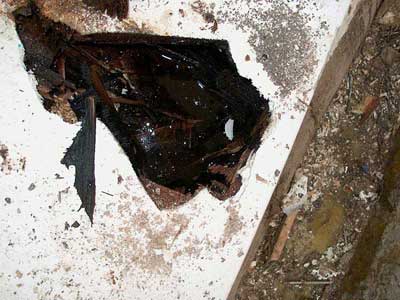|
| |
3 June 2003
With a new arsenal of
industrial reciprocating saw blades from McMaster-Carr, I took advantage
of a couple free hours in the afternoon to cut out more of the remaining
interior structure. With the salon basically empty, I concentrated
on the head and forward cabin. A few select cuts with the saw
enabled me to quickly remove the bulk of the old plywood, which I tossed
unceremoniously on the foredeck through the hatch, or out into the
cockpit. Most of the plywood came out easily, but the incredibly
thick tabbing on both top and bottom of the horizontal pieces against the
hull proved to be too tough to deal with at this juncture, so, as in the
salon, I cut the plywood inside the tabbing. I even tried my small
angle grinder, which worked fairly well--if dustily--at cutting through
the top layers of tabbing. Unfortunately, the tabbing beneath the
bunks was simply too tough to pry or beat off the hull, so I abandoned
this grinding tactic after doing one side. Later, I'll tackle the
inevitable and cut out whatever remains. For the moment, it can
wait. I removed the old fiberglass water tank; the only thing
holding it in place was the surrounding cabinetry. I also removed
the remaining portion of the cabin sole; as with the other sections, the
weak tabbing ripped out fairly easily. |
|




|
|
I left the forwardmost
bulkhead--into the chainlocker--in place. It's in good condition,
and will probably remain in place even as I begin new construction
later. I cut through the tabbing at the top edge, however. I
also removed the mast step; the nuts on the two through bolts holding it
on came right off, but the bolts were of course frozen firmly in place in
the aluminum step, so I pried it up from the top. As expected, the
underside looked like wet concrete in consistency--falling apart. I
removed the mast beam; its condition was as expected. |
|



|
|
 The
cheesy shelves and "chainplate knees" (ha!) for the forward
lowers in the forward cabin came out with a minimum of fuss; the
chainplate supports were a complete joke and came out with a light tap
from my hammer. The
cheesy shelves and "chainplate knees" (ha!) for the forward
lowers in the forward cabin came out with a minimum of fuss; the
chainplate supports were a complete joke and came out with a light tap
from my hammer.
|
|
Next, I tackled the large
head discharge seacock. Earlier, I had determined that there was no
threaded through hull fitting externally; instead, there was simply one of
the ubiquitous Pearson fiberglass tubes installed. Inside the boat,
the seacock was secured to a fiberglass and wooden fairing block with four
square-head lag screws (I had also previously determined that these had to
be screws, not bolts, as no bolt heads were apparent on the
outside). Before climbing onto the boat earlier, I had grabbed a
selection of box end wrenches from the shop in order to tackle these lags,
since earlier attempts to use some of the lame demolition-quality tools I
kept in a plastic toolbox on board had ended in dismal failure.
Imagining the size of the square bolt heads in my mind, I chose several
wrenches beginning with 5/8", thinking the heads were at least that
large. Of course, they ended up being 9/16", so I had to climb
down for the proper size. The four lags came out easily once I
chipped away some fiberglass and paint that was in the way.
However, it turned out that
the seacock was not free! Further investigation revealed that the
fitting must have been set into a bed of wet fiberglass before bolting,
meaning that it was firmly ensconced in position. Using a variety of
chisels, screwdrivers, and other tools, I made an attempt to break it
free--no dice. |
|


|
|
Since
I had my small hand maul nearby, I beat a hole into the head platform to
get an idea what was going on inside. I was expecting wet, rotten
plywood, but what I didn't expect was to find that the cavity inside the
platform was 2/3 filled with standing water! |
|

|
|
With that, I called
it quits for the day. With the interior at this stage, it
didn't make much sense to keep slaving away under the cover of the
deck. Most subsequent interior demolition and preparation will occur
once the deck is removed. |
Continue>
|
|











